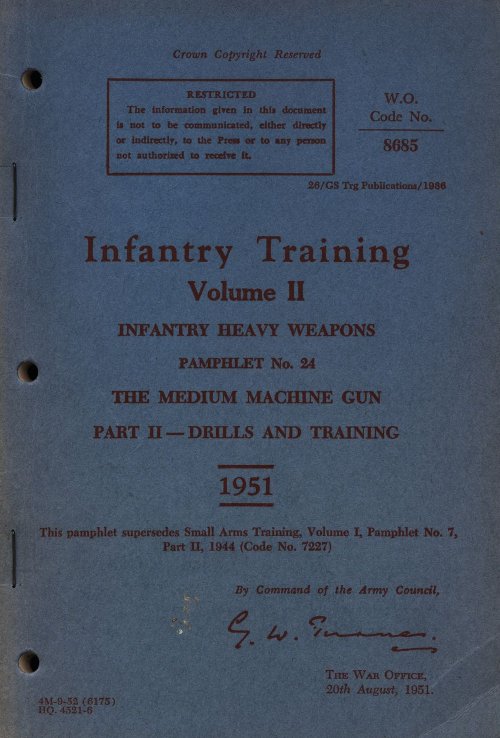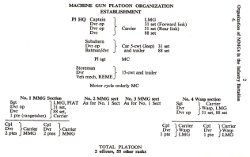Topic: Militaria

The Vickers .303-inch Medium Machine Gun

The Gun
Name.–.303 Vickers medium machine gun.
Weight.–40 lb (with water in barrel casing.
Rate of fire.–about 500 rounds per minute.
Organization of the Infantry Battalion Machine Gun Platoon (1951)
It's difficult to separate modern perceptions of infantry or ground combat with the presence and firepower of the machine gun. Before the First World War, machine guns were a tactical oddity, not quite having proven their usefulness to the point that infantry units were organized to capitalize n the machine gun's advantages, or acquired in sufficient numbers to be a decisive weapon on their own terms. The years of trench warfare in France and Flanders changed that. Machine guns not only appeared in greater numbers in infantry battalions, but as the value and relative merits of light and medium/heavy machine guns became wide recognized, organizations did change.
The challenges of organizing comprehensive machine gun firepower across a brigade's units led to the creation of Brigade Machine Gun Companies. These companies manned medium machine guns (Vickers) while the infantry battalions absorbed more light machine guns (Lewis Guns), and the Canadian Machine Gun Corps took form. By 1918, these companies were reformed into Division Machine Gun Battalions. The Canadian Corps was further supported by mobile Machine Gun units which provided a valuable degree of mobility once more open warfare commenced in the final months of the War. And by 1918, the machine gun had proven to all its tactical value.

In 1920, the Canadian Militia was undergoing examination and reorganization, with many Corps working to absorb the lessons of the Great War in both training and organizational change. Among these changes was the creation of the Canadian Machine Gun Corps in the Canadian Militia which existed from 1920 until 1936. In 1936, the units of the C.M.G.C. were disbanded, and amalgamated with infantry battalions in the Militia (thus resulting in the "(M.G.)" designation that some units held at the time). A few of these units were subsequently employed to form heavy weapons companies and served as such during the Second World War.
The formation of integral machine gun platoon in infantry battalions was also developed, and these survived in the post-war period. The images fund in this post are taken from the 1951 editions of the Infantry Training manuals for The Medium Machine Gun.


manuals for the .303 Vickers Machine Gun. 1951 Part II - Drills and Training (left); and Range tables (1939) (right). Click cover images for larger image.


